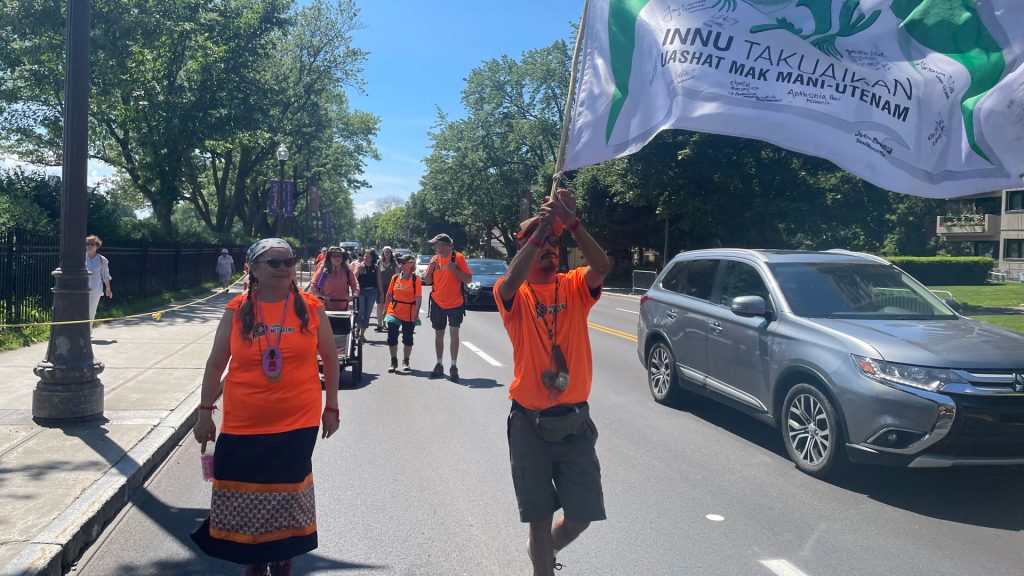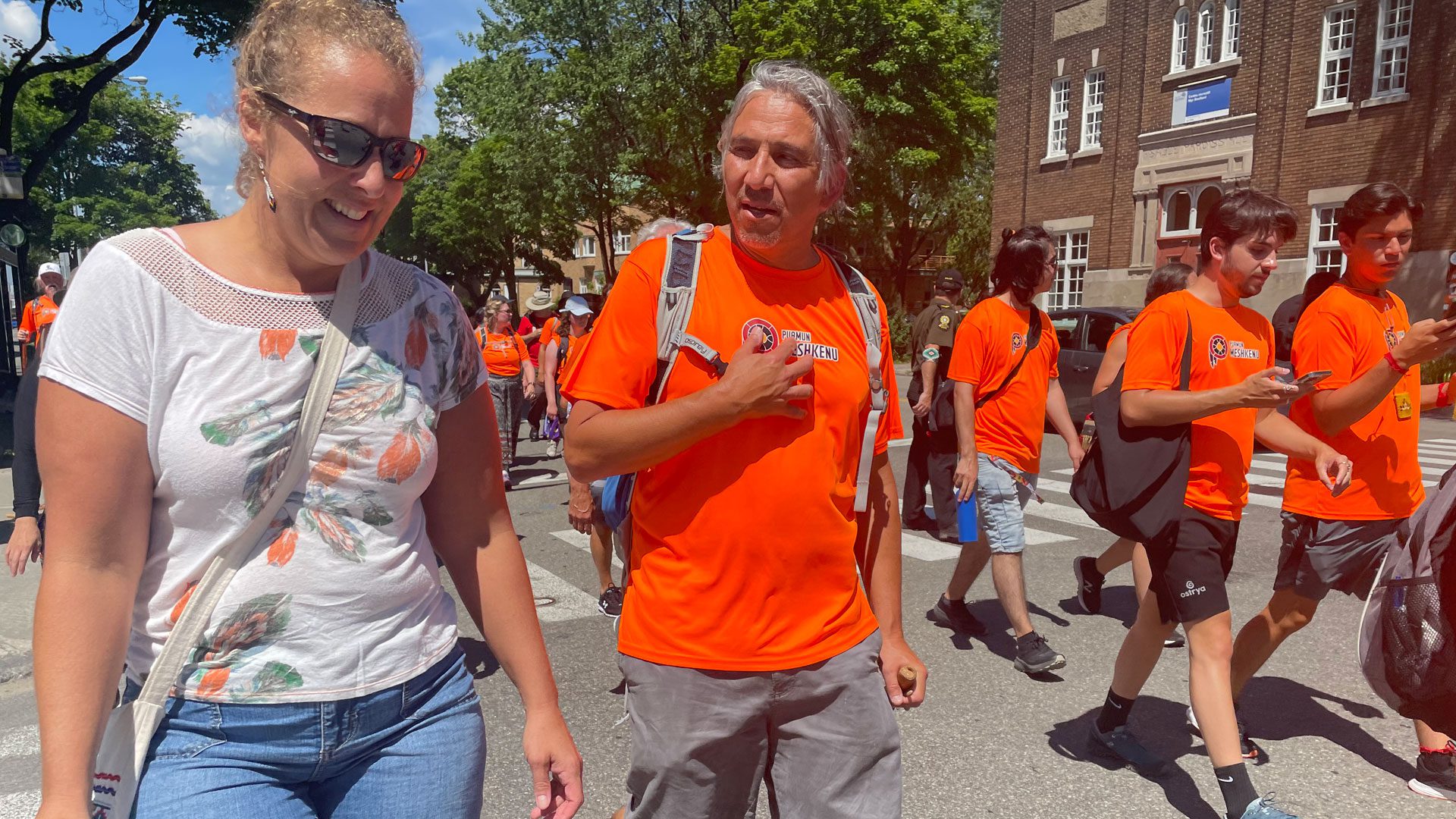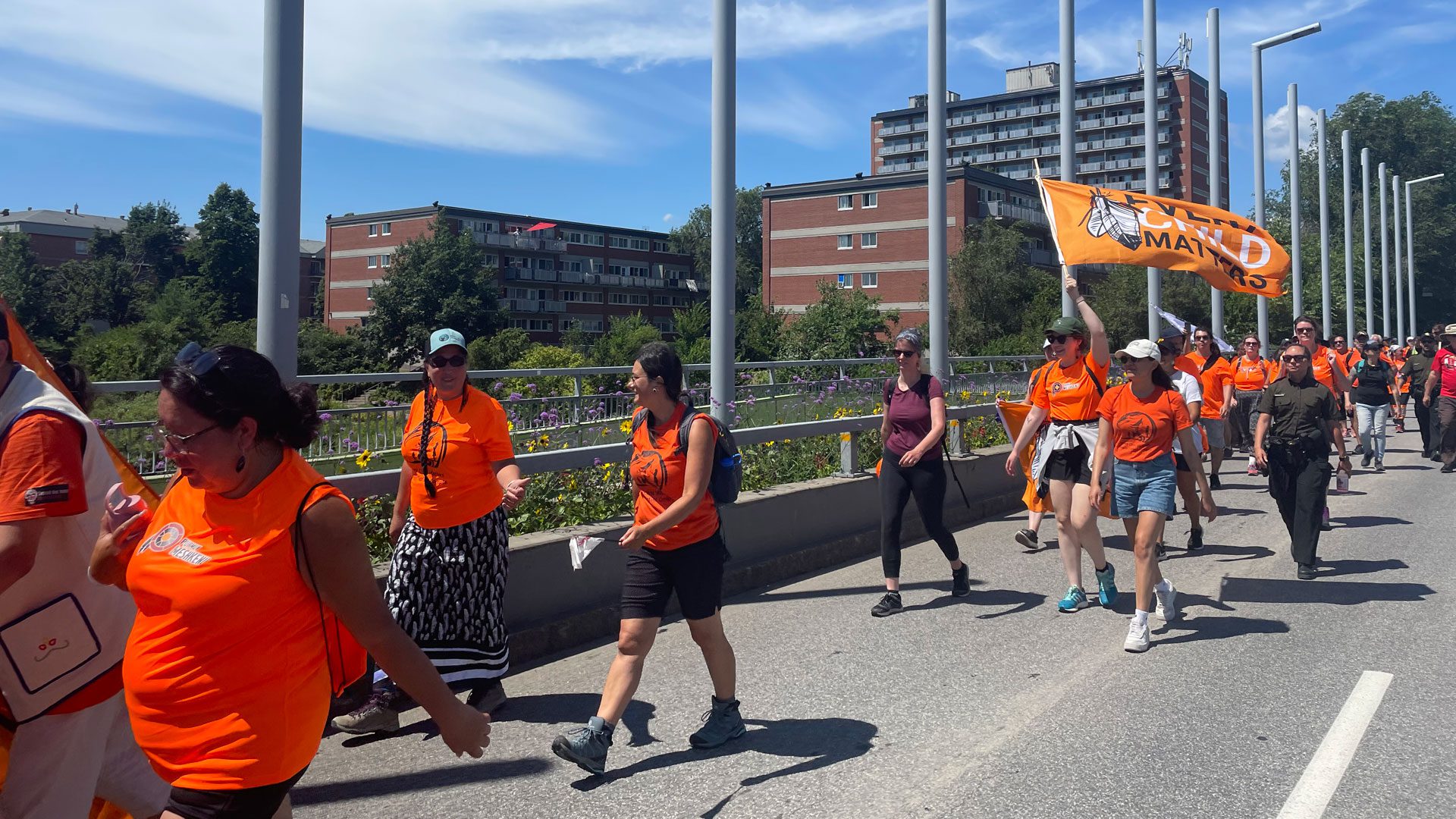
After six days of being on the road, a stream of people clad in bright orange shirts filed along a boulevard in Quebec City under the hot summer sun.
The group started out with 13 marchers — but the number increased to about 100 after their stop in Wendake for the last leg of their walk.
New additions included Assembly of First Nations Quebec Labrador Chief Ghislain Picard and Quebec’s Indigenous Affairs Minister Ian Lafrenière.
March organizer Jay Launière-Mathias said despite some sore feet and blisters, morale was high.
“I think they’re galvanized by the enthusiasm, by the fact that there are new marchers that joined us to walk the last 15 km, so I think it’s going well overall,” he said in French.

The Puamun Meshkenu walkers have traversed 275 km from Mashteuiatsh to Quebec City in a symbolic journey to meet the Pope.
They’re Anishinaabe, Atikamekw, Innu, Naskapi and Wendat. Some are equipped with walking sticks, some with large flags. The Indigenous non-profit that organized the walk’s name, Puamen Meshkenu, means “path of a thousand dreams.”
“This project started from a dream that we had few weeks ago, and in less than three weeks we succeeded in organizing this march to mobilize people to participate. I mean, it’s the most beautiful proof that you need to believe in your dreams,” said Launière-Mathias.
On Tuesday, a large crowd greeted the Puamun Mashkenu group in front of the Wendake Health Centre, their final pit stop before those last 15 kms to Quebec City.
Stanley Vollant, an Innu surgeon and Puamen Meshkenu’s president, joined the group Sunday.
“There were 13 people walking, but thousands were with them,” said Vollant.

He’s referring to the spirits of the victims of residential schools, whose presence he felt over the course of his journey.
Vollant was unable to do the full walk but was determined to participate.
The march from Pointe-Bleue residential school to Quebec was particularly significant to Vollant because his mother attended that very residential school as a child.
“My mom didn’t have a happy childhood or life, and she died prematurely at 52 years old from alcoholism. She died too young because alcohol might have been her way of healing from her trauma, from her demons,” he said.
Vollant and the rest of the group hope the papal visit brings healing.
Billy Ray Chachai-Piché had sore feet on the first day of the walk but said he was feeling better than ever on the final day.
“Today I’m feeling in super good shape, and ultra-determined to achieve my goal: to be a visible role model, to show the importance of the impacts of residential schools on Indigenous Peoples across Canada,” said Chachai-Piché.
“At the Wendake Health Centre, I didn’t hold back my tears. I cried for ten minutes. I think because I was happy to have represented the pride of my family because I did this walk. I had low self-esteem, and I wanted to show that I take pride in my life,” he said.

Launière-Mathias said that no one in the group walked the entire 275 km individually.
“After the first day, some people were disappointed that they weren’t able to walk as much as they had wanted to, but what we explained to them was that this is a team effort, not an individual challenge. That’s when they got a new perspective on this walk. The kilometers you’re able to walk individually contribute to the collective,” he said.
While marchers who needed a break travelled in the group’s van, they were contributing in a different way — helping with logistics, talking to the people walking, or offering emotional support.
“The collective is so important to Indigenous Peoples, and that shows at our scale of 13 marchers,” said Chachai-Piché.
Marchers discussed the importance of the Catholic Church taking more substantial action — like releasing records to the public.
“One day [the Church] needs to give us the Church archives on sexual assault, and the apologies, they need to be deeper,” said Chachai-Piché.
“I hope the head of the Church, the pope, will reach out to say we’ll assume our part of the reparations, and give access to their archives. For us, it’s important to know what happened, the communications that happened, and find the people who disappeared, maybe charge the people who are still alive who committed crimes,” said Vollant.
Elder Jean-Charles Pietacho met up with the group in Wendake. He said he’s dissatisfied with the Pope’s apology.
“I sincerely believed the Pope was going to apologize in the name of the Catholic Church, and that’s not what I heard. He blamed Christians, and really, I don’t know what that means, Christians, is it me, is it you… No, I’m very disappointed, very disappointed as a residential school survivor who attended the Malioutanem residential school,” said Jean-Charles Pietacho at the Wendake site.
“No, I’m still hurting.”
He’s been the grand chief of Ekuanitsihit for over 30 years and seen commissions come and go without much change happening, so Pietacho has reason to be skeptical.
But he said he is inspired by the initiatives of the younger generation and believes the media draw of the pope could prove to be useful for Indigenous Peoples.
“I’m seeing the media and it’s all over the world, and that, in spite of everything, is positive. People will be better informed. Because for me, I have friends that told me that they didn’t even know I was a residential school survivor. So ignorance, if we can break that type of prejudice too,” he said.
Along the last leg of Puaman Meshkenu’s journey, cheers erupted periodically and rippled down the line of marchers, by-standers waved and cars honked in support.
Some people asked why they were marching, and they were answered with “for residential school survivors,” one person answered, “for those, we have lost,” said another.
People chanted every child matters while pow wow music played through portable speakers and some of the marchers slipped into a powwow step as they approached the Plains of Abraham, despite their tired feet.
When the group finally reached their destination, they were greeted with cheers, hugs, water and a packed lunch.
Puamen Meshkenu’s walk is finished, but the journey towards healing is just beginning.










